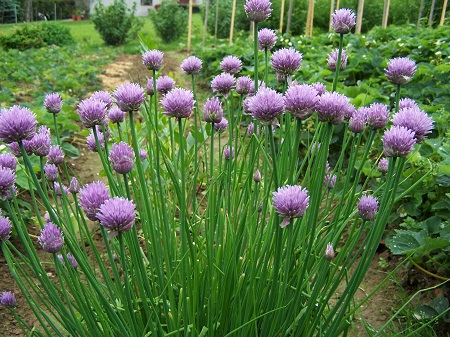Getting Fresh: Chive Talkin'
By John DiGilio in Food on Jun 29, 2011 6:40PM
 Getting Fresh is a seasonal exploration of fresh herbs. From cultivation to cooking, join us as we get our hands dirty and add a little extra spice to life. If you have any favorite uses for the herbs we cover or questions, please share them in the comments section.
Getting Fresh is a seasonal exploration of fresh herbs. From cultivation to cooking, join us as we get our hands dirty and add a little extra spice to life. If you have any favorite uses for the herbs we cover or questions, please share them in the comments section.
You have probably seen their little green straws floating in your soup or had them sprinkled on a baked potato to add a bit of verdancy to the heaps of butter or sour cream. Chives are common, yet treasured, in culinary and gardening circles. They are well known for their flavor in food preparation and utility in the garden. Yet what exactly is a chive? To most of us as diners, they are just more "green bits" that are easily taken for granted. For cooks and cultivators, chives are something far more magical.
Though they may look like lawn trimmings, chives are actually a type of onion. Whereas most onions are prized for their pungent and sharp-tasting bulbs, chives are prized for what grows above the ground - their leaves. Skinny stalks of green; they possess a spicy flavor that is far more delicate and subtle than their larger cousins. As such, they do not overpower the dishes in which they are incorporated. Instead, chives complement and even highlight the flavors of soups, salads, vegetables and even fish. One of our favorite uses for them is in omelets. They can give egg dishes just a little bit of a kick.
Chives are easy to grow on your own and actually bring a few added benefits to the garden. Best grown outside in an actual bed, they can be started indoors. All you need are some seeds and good potting compost. They do not require a lot of light, but they do need water. Your soil should be kept moist. Seedlings tend to sprout in less than a week and should be transferred to the garden after about a month of growth. Once they are in the ground, the real versatility of the chive manifests itself. In addition to being harvested for use in the kitchen, chives make for a lovely garden plant. Standard North American varieties bloom into brilliant purple tufts. The flowers are even edible. Talk about a great way to garnish your salads with some color! They are also one of nature's own insect repellants. Plant them around your more prized flowers to ward off aphids and spider mites.
Every so often, chives should be thinned out for optimal growth and propagation. Simply dig them up, separate the bulbs and replant them. Chives are perennial and will grow year after year without getting out of control. When harvesting the leaves, simply snip them with scissors. This is also the best way to cut them up for use in your kitchen. Chives also freeze nicely and will retain their flavor for months. Our favorite way to use them, of course, is fresh from the garden. We like to mix them with other fresh vegetables and herbs, such as in this Summer Tomato Salad below. Enjoy!
Fresh Summer Tomato Salad
- 3-4 large ripe tomatoes, chunked or sliced
- 1/4 cup extra-virgin olive oil
- 2 tablespoons fresh thyme, chopped
- 2 tablespoons fresh oregano, chopped
- 2 tablespoons fresh parsley, chopped
- 2 tablespoons fresh chives, snipped into small pieces with scissors
- 2 tablespoons minced garlic
- 3-4 small balls of fresh mozzarella cheese, sliced
- Freshly-grated parmesan cheese (optional)
- Salt and ground pepper to taste
Arrange the tomatoes (slices or chunks) and mozzarella in a shallow dish or bowl and set aside. Make your dressing by whisking the olive oil, thyme, oregano, parsley, chives, and garlic together in a small bowl. Add salt and ground pepper to taste. Pour the dressing over the tomatoes and cheese, covering evenly. Top with Parmesan cheese, if desired, cover, and allow to chill in the refrigerator for at least an hour before serving.
Photo by Jerzy Opioła.
Other articles in this series: